Abstract
Of the various tumour types, colorectal cancer and brain tumours are still considered among the most serious and deadly diseases in the world. Therefore, many researchers are interested in improving the accuracy and reliability of diagnostic medical machine learning models. In computer-aided diagnosis, self-supervised learning has been proven to be an effective solution when dealing with datasets with insufficient data annotations. However, medical image datasets often suffer from data irregularities, making the recognition task even more challenging. The class decomposition approach has provided a robust solution to such a challenging problem by simplifying the learning of class boundaries of a dataset. In this paper, we propose a robust self-supervised model, called XDecompo, to improve the transferability of features from the pretext task to the downstream task. XDecompo has been designed based on an affinity propagation-based class decomposition to effectively encourage learning of the class boundaries in the downstream task. XDecompo has an explainable component to highlight important pixels that contribute to classification and explain the effect of class decomposition on improving the speciality of extracted features. We also explore the generalisability of XDecompo in handling different medical datasets, such as histopathology for colorectal cancer and brain tumour images. The quantitative results demonstrate the robustness of XDecompo with high accuracy of 96.16% and 94.30% for CRC and brain tumour images, respectively. XDecompo has demonstrated its generalization capability and achieved high classification accuracy (both quantitatively and qualitatively) in different medical image datasets, compared with other models. Moreover, a post hoc explainable method has been used to validate the feature transferability, demonstrating highly accurate feature representations.
1. Introduction
In recent years, both colorectal cancer (CRC) and brain tumour are considered among the most dangerous types of cancer, affecting both men and women around the world [1,2,3,4]. Deep learning has shown great potential as a diagnostic tool in handling various complex problems that automate the feature engineering process of the medical image analysis pipeline [5,6]. Convolutional neural networks (CNNs) are among the most effective deep learning algorithms, where impressive achievements have been made in the field of medical imaging [7,8,9]. The effectiveness of CNNs comes from their ability to detect local features within an image in a hierarchical manner. More precisely, CNN’s low-level layers are designed to encode generic representations for most vision tasks, while the high-level layers can learn more complex features. There are two different scenarios for training a CNN model: full training and transitional training. Training a model from scratch requires the initialisation of the whole network from end-to-end. This strategy is a less common approach and requires a large amount of annotated training data that are not typically available in the field of medical imaging [10]. Rather, transitional learning refers to extracting the knowledge gained from a pre-trained network and applying it to another (un)related task, making it faster and more practical with small datasets [11]. Traditionally, transitional training (or as commonly known as transfer learning) can be achieved by one of the following scenarios [12,13,14]: (a) “shallow tuning”, which aims at modifying only the network’s classification layer to handle the domain-specific task [15]; (b) “deep tuning” refers to retraining the weights of the whole network in an end-to-end fashion [16]; or (c) “fine-tuning” mode, which starts to retrain weights of the last layer and gradually retraining weights of more layers until the desired performance is reached [17].
Although transfer learning can contribute to the problem of data scarcity, the feature transferability process might be affected when domain-specific images are different from generic images used in CNN’s initial training. Thanks to the huge availability of unlabelled data, many researchers designed self-supervised learning solutions to cope with the lack of labelled training data, especially in the medical imaging domain [18]. In self-supervised learning, a pretext training model that is learned from a large amount of unlabelled data is utilised to generate useful feature representations that can be used to solve a new task called the downstream task. In [19], we previously developed a self-supervised model, called Self-Supervised Super Sample Decomposition (4S-DT), where a large number of unlabelled chest X-ray images were used in the pretext training task. Then, a fine-tuning strategy based on an ImageNet pre-trained network was employed to achieve coarse transfer learning to detect samples of new classes in a small dataset with data irregularity problems. 4S-DT could deal with datasets with irregularities in their distributions. However, the downstream recognition component has been designed in a semi-automated way based on a pre-defined parameter to identify the number of sub-classes. More importantly, the quality of the sub-classes can affect the transferability capability of the model based on the underlying statistical distribution of the data. Motivated by these issues, in this paper, we propose a new model, called (XDecompo), where class decomposition is guided by the affinity propagation (AP) method [20]. XDecompo has a more generalisation capability, compared to 4S-DT, due to the non-parametric nature of its class decomposition. Specifically, AP has shown more stable clustering results over k-means with a lower mean squared error when applied to greyscale images, even when compared to the best out of 100 runs of k-means [20]. Motivated by this experimental observation, we hypothesised that clear class boundaries between pairs of sub-classes have a positive effect on the transferability of features in the downstream task. As a consequence, the explainability of the model can be enhanced. Thus, the contributions of this work can be summarised as follows:
- Propose a new model, XDecompo (the developed code is available at (https://github.com/Asmaa-AbbasHassan/XDecompo accessed on 14 November 2022)), using an affinity propagation-based class decomposition mechanism to robustly and automatically learn the class boundaries in the downstream tasks.
- Investigate the generalisation capability of XDecompo in coping with different medical image datasets.
- Demonstrate the effective performance of XDecompo in feature transferability.
- Validate the robustness of XDecompo using a post hoc explainable AI method for feature visualisation, compared to state-of-the-art related models.
The paper is organised as follows: Section 2 reviews the state-of-the-art approaches in medical image classification with an overview of explainable AI in medical imaging. Section 3 discusses the main components of the XDecompo model. Section 4 describes our quantitative and qualitative experiments on two different medical image datasets. Section 5 discusses and concludes our work.
2. Related Work
Deep convolutional neural networks (DCNNs) are widely used in several diagnostic applications. For example, in [21], a CNN was used to classify colonic polyp into two classes; they are normal and abnormal based on patch images and several data augmentation processes. The adapted CNN consisted of three convolutional layers with different kernel sizes, each one followed by max-pooling layer. In [22], a CNN model was used to classify digitised images of colorectal cancer cases as benign hyperplasia, intraepithelial neoplasia, and carcinoma. The proposed architecture consisted of two convolution layers, max-pooling and ReLUs layers, and the training was based on stochastic gradient descent. In [23], the authors modified different pre-trained networks by replacing the classification layer with a global average pooling for colonic polyps detection. Moreover, CNN was used as a feature extractor in many works. For instance, in [24], a comparative study between a transfer learning from VGG-16 pre-trained network and a CNN architecture as a feature extractor, with a support vector machine (SVM) as a classifier to classify a large number of images patches into three histological categories; healthy tissue, adenocarcinoma, or tubulovillous adenoma. The results showed that the transfer learning techniques from a pre-trained network outperform the other method in terms of accuracy and time consumption. Similar to colorectal cancer, brain tumour is a common disease between adults and the elderly that severely affects the function of the body. There are numerous types of brain tumour, some benign, while others malignant. The most frequent types are glioma, meningioma, and pituitary tumours. Thus, early tumour detection plays a significant role in improving treatment outcomes and increasing patient survival. In [25], three dense layers with softmax activation function were combined at the inception of ResNet v2 to classify the brain tumour into three classes. In [26], transfer learning based on GoogleNet pre-trained network was used to extract features from brain MRI images and fed them into SVM and KNN as classifiers, separately, to classify the input image into three classes; glioma, meningioma, and pituitary tumours. In [27], a CNN architecture has been evaluated based on various pre-processing techniques. The architecture consisted of 18 layers divided into four convolution layers, each one followed by batch normalisation, Relu, max-pooling layer, and fully connected layer with softmax activation function to classify brain cancer into three types of tumour. In [28], a differential deep CNN model was proposed to classify MRI images into two classes (normal and abnormal). In [29], the authors used different sizes of the brain tumour region with several processing techniques of data augmentation to evaluate the performance of CNN based on the VGG-19 pre-trained network.
Although the transfer knowledge from a pre-trained network has superior outcomes, it sometimes fails when a dataset has data irregularity problems or imbalance classes [30,31,32]. Decomposition mechanisms can handle this issue by detecting the boundaries between classes and learning the local patterns of a dataset [33]. The basic idea of the decomposition mechanism is to break down the original classes in a dataset into simpler sub-classes. Then, each sub-class is given a new label associated with its original class and treated as an individual new class. Then, after training, those sub-classes are recollected again to compute the error correction of the final prediction. We argue that this can improve the classification performance of a dataset with irregularity distribution classes, which was clear from the experimental results in [34] that class decomposition was used in medical image classification for transfer learning, in a method called the Decompose, Transfer, and Compose (DeTraC) approach. In [35], self-supervised learning is used with several deep convolution neural networks for many image and video analysis applications. For example, in [36], a self-supervised learning approach based on context distortion was used in different problems in medical imaging; such as segmentation, classification, and localisation. In classification tasks, the method achieved classification progress when used to detect scan planes in 2D fetal ultrasound images. In [19], a self-supervised model based on sample decomposition (called 4S-DT model) was proposed to capture complex features with highly nonlinear mapping between input and output data using stacked autoencoder (SAE) and density-based spatial clustering of applications with the noise (DBSCAN) method in the pretext task. 4S-DT model has demonstrated its capability in coping with both data scarcity and irregularity problems.
3. Explainability AI in Medical Imaging
Although machine learning and deep learning models have achieved impressive prediction results, it is not clear what the model has learnt from the input data, leading to its decisions; these models are called black boxes. The explainability AI methods [37,38,39] give solutions to break down these black boxes and provide evidence to give confidence in the results in a way that experts in the field can understand. Different applications have widely depended on transparent techniques to introduce the results, such as face recognition [40], medical imaging [41,42], text translation [43], speech understanding, and generate human responses [44]. These techniques are important in healthcare to provide the community with models that are more trustworthy to match human experience. This is done by having the ability to indicate the significant pixels that drive the model to make its decisions and decide which class the patient belongs to (e.g., healthy or unhealthy) [45,46]. The visualisation of an explainable AI can be accomplished through various attention mechanisms such as: trainable, post hoc, soft, and hard attention scenarios [47,48]. A trainable attention mechanism is trained while the model is in the learning process to help the network focus on the important pixels of the image, while the post hoc attention method is applied after completing the training process with fixed weights to create a heatmap of occlusion [37], saliency [49], CAM [50], or Grad-CAM [51] maps. On the other hand, soft attention can be trained with the standard backpropagation method that is described by continuous variables, while hard attention is depicted by discrete variables; hence, it is non-differentiable and uses the crop method to focus on specific areas in the image. In this work, we adopted the Grad-CAM algorithm as a post hoc explainable method on top of the XDecompo model to quantify the contribution of each pixel of input images in the final prediction of the model and to explain the robustness of the feature speciality and transferability.
XDecompo Model
XDecompo model is composed of the following four main stages, see Figure 1:
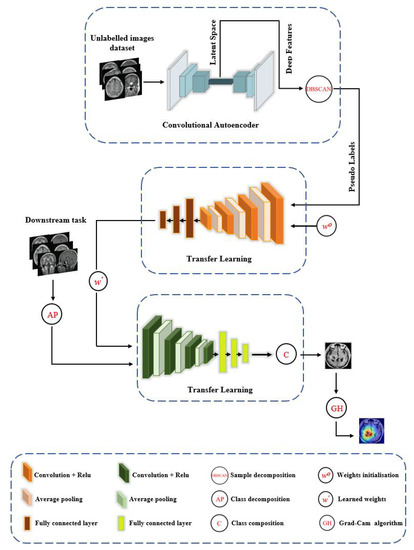
Figure 1.
The framework of the XDecompo model.
- Pseudo-Labels: Extraction of deep local features from a huge number of unlabelled images using convolutional neural networks with a sample decomposition approach. We used the density-based spatial clustering of applications with the noise (DBSCAN) method [52] as a clustering algorithm for the annotation of pseudo-labels. DBSCAN is an unsupervised clustering algorithm that can cluster any type of data containing noise and outliers, without prior knowledge of the number of clusters.
- Pretext Training: Using an ImageNet pre-trained network, such as ResNet-50, to classify pseudo-labelled images and achieve coarse transfer learning; where all layers were learnt as a deep-tuning mode to construct the feature space. The CNN model was trained with a cross-entropy loss function based on a mini-batch of stochastic gradient descent (mSGD) [53] to optimise the model during training.
- Downstream Training: Utilisation of learned convolutional features with a novel class decomposition approach to solve a new task (i.e., downstream training) in a small dataset.
- Feature Visualisation: Explanation and demonstration of the speciality of features learned/transferred by XDecompo, we used the Grad-CAM algorithm [51] as one of the most efficient interpretation techniques for computer vision tasks. It estimates the location of particular patterns in the input image, which guides the prediction of the XDecompo model, and highlights the patterns through an activation heatmap [54]. Grad-CAM is a generalisation of CAM that does not require a particular CNN architecture, contrary to CAM which requires an architecture that applies global average pooling to the final convolutional feature maps.
More precisely, we (a) use the convolutional autoencoder (CAE) [55] for the feature extraction in the pretext task; and (b) adopt the Affinity propagation (AP) [20] clustering method for the downstream task. CAE works by applying squared convolutional filter scans over the whole image to extract local features by compressing the image into a low dimension (e.g., encoder process), and then reconstructing the original values back (e.g., decoder process). The encoder process begins with several blocks, and each block consists of a convolution layer with a nonlinear activation function such as ReLU, and a pooling layer that downsamples the input image. The 2D convolution operation can be defined as:
where is the output activation map in position (i,j), x is the input image, and w is the weights of square convolution filter with dimension . For d depth, the generated activation maps are the encoding of the input x in a low-dimensional space, which can be defined as:
where is an activation function, is the bias for d-th activation maps. Since our aim is to reconstruct the input x from the generated activation maps, we need to up-sample the compressed image. The reconstructed image is obtained by:
where defines the inversion process on both dimensions of the weights and H is a group of activation maps. The cost function to minimise the error between and x with the mean squared error (MSE) is defined as:
Once the training of the CAE is accomplished, DBSCAN was used to generate the pseudo-labels. Let an image (encoded as ) be density-connected to an image (encoded as ) with respect to (the neighbourhood radius) and (the minimum number of objects within the neighbourhood radius of the core object) if there exists a core object such that both and are directly density-reachable from with respect to and . Moreover, an image is directly density-reachable from an image if is located within the -neighbourhood of , and is a core object. The -neighbourhood can be defined as:
DBSCAN results in c clusters, where each cluster is generated by maximising the density reachability relationship among images. The c cluster labels will be assigned to the unlabelled images (and will be presented as pseudo-labels) for the pretext training task of the self-supervision mechanism. The pseudo-labelled image dataset from the pretext task can be defined as .
For the downstream task, the distribution of the image data X is broken down using the AP method into some classes c based on the extracted features . The AP algorithm is an unsupervised clustering algorithm that does not require an initial number of clusters, and it depends on the idea of how messages are passed between data points; for example, how well the j-th point is appropriated to become an exemplar for the i-th point. Let the image dataset , and the function represents the similarity of two points that can be described as a negative squared Euclidean distance as below:
where and are the positions of data points i and j in 2D space. The algorithm proceeds by alternating between two message-passing steps, which update two matrices as below:
where refers to the “responsibility” matrix that quantifies how suitable is to serve as the exemplar for in comparison to other potential exemplars for , and is the “availability” matrix that depicts how “proper” it would be for to choose as its exemplar, taking other points’ preferences for as an exemplar into account.
Here, in this work, we used the cosine similarity measure for AP to learn the boundary between certain features within each class. Cosine similarity is a structural similarity measure based on the idea that two vectors are supposed to be similar if they have many neighbours in common, where a similarity of 0 indicates that the vector orientation is completely different, while a similarity of 1 indicates that the vector orientation is the same.
As a fine transfer learning stage, XDecompo employs a fine-tune mode in the pre-trained model that has already been trained in the pretext stage to address the new downstream task (of the small annotated samples). Additionally, a class decomposition layer was adapted in XDecompo to split each class within the downstream dataset (denoted as dataset A) into c sub-classes, resulting in a new dataset (denoted as dataset B). Then, the new sets are given new labels, where each subset is treated as an individual class. Another important step is to reduce the feature space of a high dimension to a lower dimension using a principal component analysis (PCA) process [56], which is important for class decomposition to produce more homogeneous classes, reduce memory requirements, and improve framework efficiency. The class decomposition process can be defined as
where the number of examples in both A and B are equivalent, while encodes the new generated labels associated with the sub-classes (e.g., ). These sub-classes are then integrated back into the original classes in the dataset (the composition stage) and the final prediction is calculated accordingly.
Finally, we used the Grad-CAM algorithm to locate specific patterns in the input image, which informs the XDecompo model’s prediction, and emphasises the patterns using an activation heatmap. The basic idea behind Grad-Cam is that the weights of a convolutional layer are calculated using a gradient of the classification score of a particular class c, for the feature activation map on the d-th feature map. Then, the importance of the associated neuron of each feature map d is calculated by taking the global average pool of gradients at position as follows:
where m is the number of pixels in . Finally, the sum of the product of the with the corresponding feature map is performed under the ReLU activation function to obtain the final Grad-CAM heatmap as follows:
4. Experimental Setup and Results
This section discusses the experimental results, as well as the datasets used to validate the generality and explainability of XDecompo.
4.1. Datasets Description
In our work, we used two different medical image datasets, they are colorectal cancer histology dataset and brain tumour dataset (see below). These datasets have been selected due to (a) the presence of several data irregularity problems, including class overlap in terms of the morphological structure of objects within the images and the class imbalance problem; and (b) the huge availability of unlabelled related images [57].
- Colorectal cancer images dataset, the labelled and unlabelled datasets were used from [58]; from the NCT Biobank, (National Center for Tumor Diseases, Heidelberg, Germany), and the UMM pathology archive (University Medical Center Mannheim, Mannheim, Germany). The dataset “NCT-CRC-HE-100K” [58] was used as unlabelled samples. With a total of 100,000 samples of (CRC) and normal tissue, all images are 224 × 224 pixels at 0.5 microns per pixel, the dataset divides into nine classes: Adipose tissue, background, debris, tumour epithelium, smooth muscle, normal colon mucosa, cancer-associated stroma, mucus, and lymphocytes.
- The dataset “CRC-VAL-HE-7K” [58] was used as a labelled dataset, a set of 7180 image patches divided into nine unbalanced classes, and all images are 224 × 224 pixels at 0.5 microns per pixel. In our experiment, we only used three classes, Adipose (ADI), stroma (STR) and tumour epithelium (TUM), which contain 1338, 421, and 1233, respectively. Then, the dataseet was divided into three groups: 60% for training, 20% for validation, and 20% for testing, see Table 1. Figure 2 shows example images from the test set. Note that there is no overlap with the cases in the unlabelled images, NCT-CRC-HE-100K.
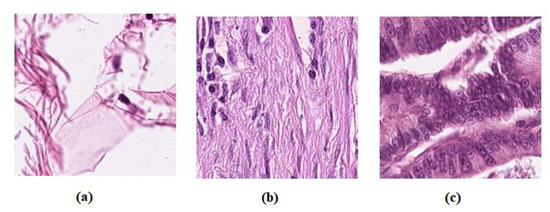 Figure 2. Example images from colorectal cancer test set: (a) ADI, (b) STR, and (c) TUM.
Figure 2. Example images from colorectal cancer test set: (a) ADI, (b) STR, and (c) TUM. - Brain tumour images dataset, we have used a public brain tumour dataset as unlabelled samples that contains a total of 253 images and divided into two classes: 155 tumours and 98 without tumours. The dataset is available for download at: (https://www.kaggle.com/datasets/navoneel/brain-mri-images-for-brain-tumor-detection access on 14 November 2022). We applied many data-augmentation techniques to generate more samples in each class, such as reflection, shifting, wrapping, and rotation with various angles. This process resulted in 45,960 brain tumour images.
- For the labelled dataset, we have used a set of 3064 brain tumours from Nanfang and General Hospitals, Tianjin Medical University, China: 1426 glioma, 708 meningiomas, and 930 pituitary tumour, available from [59], all images with size 400 × 400 pixels. The training set was randomly divided into 60% to fit the model, 20% for validation, and 20% as a test set, see Table 2. Figure 3 shows examples of images from the test set.
 Table 1. The distribution of Colorectal cancer dataset.Table 1. The distribution of Colorectal cancer dataset.
Table 1. The distribution of Colorectal cancer dataset.Table 1. The distribution of Colorectal cancer dataset.Class Name Training Validate Test Total ADI 856 214 268 1338 STR 270 67 84 421 TUM 789 197 247 1233  Table 2. The distribution of Brain tumour dataset.Table 2. The distribution of Brain tumour dataset.
Table 2. The distribution of Brain tumour dataset.Table 2. The distribution of Brain tumour dataset.Class Name Training Validation Test Total glioma 855 285 286 1426 meningioma 424 141 143 708 pituitary_tumour 558 186 186 930 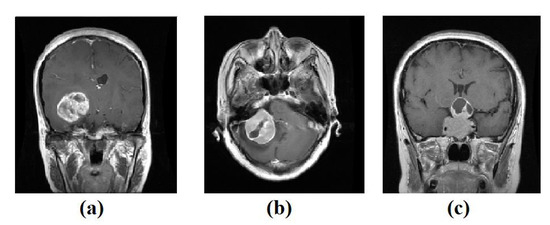 Figure 3. Example images from Brain tumour test set: (a) glioma, (b) meningioma, (c) pituitary tumour.
Figure 3. Example images from Brain tumour test set: (a) glioma, (b) meningioma, (c) pituitary tumour.
To quantitatively and qualitatively evaluate the performance of XDecompo, we utilised ResNet-50 ImageNet [60] as a backbone network. We used a fine-tuning mode by gradually training more layers and tuning the learning parameters until a significant high performance is achieved. Here, we consider freezing the lower layers and updating only the weights of upper layers (i.e., the last four layers), see Table 3. All experiments have been implemented in MATLAB 2021a on a desktop machine with an Intel(R) Core(TM) i3-6100 Duo processor @ 3.70 GHz, NVIDIA Quadra P5000GPU, and with a RAM capacity of 16.00 GB.

Table 3.
Fine-tuned ResNet-50 architecture that we used in our experiments.
4.2. Self-Supervised Training on Unlabelled Images
For the 4S-DT, we used the SAE model with 600 neurons in the first hidden layer, 400 neurons in the second hidden layer, and 200 neurons for the latent space representation to train a randomly selected 50,000 unlabelled CRC images. In addition, the same SAE architecture was used for the 45, 960 unlabelled brain tumour images, see Figure 4.
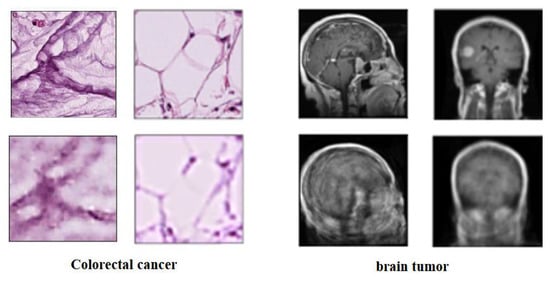
Figure 4.
The SAE for unlabelled images; first row: the original images of the dataset, second row: the reconstructed images.
For XDecompo, we applied CAE on the same selected unlabelled images dataset. Here, we used two convolutional layers with a kernel size of 3 pixels and ReLU as an activation function. For the histological dataset, the number of filters in the first layer was set at a value of 64, and the second layer at a value of 32. Regarding the brain tumour image dataset, the number of filters in the first and second layers was set at a value of 32 and 16, respectively; see Figure 5.
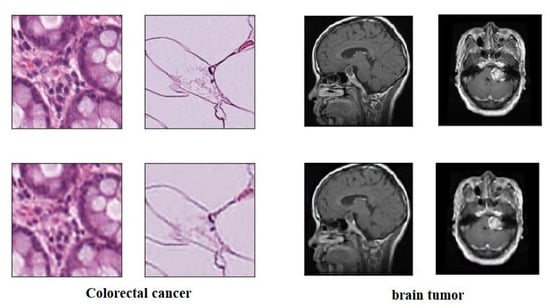
Figure 5.
The CAE for unlabelled images; first row: the original images of the dataset, second row: the reconstructed images.
Then, the extracted features obtained by the latent representation were used to construct the clusters (and hence generate the pseudo-labels) using the DBSCAN clustering algorithm. The k-nearest neighbour (k-NN) [61] was used to choose the ideal value . This is done by calculating the average of the distances of every point in the input data to its neighbours, corresponding to . The optimal value and pseudo-labels for SAE and CAE are summarised in Table 4. The autoencoder (AE) models were trained with a 0.001 learning rate, with a mini-batch size of 128 and a minimum of 100 epochs. Finally, we used the ResNet-50 pre-trained CNN model for the coarse transfer learning stage (of the pretext task). The model was trained with a learning rate of 0.0001 and a drop learning rate of 0.9 every 10 epochs.

Table 4.
The classification performance of ResNet-50 pre-trained model on the pseudo-labelled Colorectal cancer and Brain tumour datasets.
4.3. Downstream Class-Decomposition of 4S-DT and XDecompo
To decompose the labelled samples of the downstream dataset, we applied AlexNet [62] pre-trained network-based with a shallow-tuning mode to extract discriminative features from images of the original classes on each dataset. The learning rate was set at 0.0001, which was gradually reduced by 0.9 after every 3 epochs, the batch size of the training set was set at 128 with a minimum of 100 epochs, and the weight decay was set at 0.0001 to avoid overfitting and 0.9 for the momentum speed. The gradient descent (SGD) method was adopted to minimise the loss function. At this point, 1000 attributes had been collected; therefore, we utilised Principal Component Analysis (PCA) to make the feature space less dimensional. For the CRC dataset, we obtained 23, 3, and 16 for adipose, stroma, and tumour epithelium, respectively; see Figure 6. Regarding the brain tumour dataset, we obtained 6, 5, and 14 features for glioma, meningioma, and pituitary_tumour respectively, see Figure 7. For the class decomposition process, we used k-means algorithm [63]. k-means is one of the most popular unsupervised machine learning algorithms that divides a given dataset into a fixed number of clusters. The number of clusters is represented by a predetermined parameter k. The clusters are then placed as points, and all observations or data points are connected to the closest cluster that has similar properties. The procedure is then repeated with the new adjustments until the desired result is achieved (no or limited changes in cluster assignment). For 4S-DT model, we used k = 2 (where the choice was based on the high performance obtained by the models DeTraC and 4S-DT as indicated in [19,34]), and therefore, each class in () is divided into two sub-classes, each was assigned as a new label to the new dataset.

Figure 6.
The explained variance of the principal components for each class in the CRC dataset: (a) ADI, (b) STR, and (c) TUM.

Figure 7.
The explained variance of the principal components for each class in the Brain tumour dataset: (a) glioma, (b) meningioma, (c) pituitary tumour.
On the other hand, in XDecompo, the AP algorithm was used with the measure of cosine similarity. The damping factor value was set at 0.9 and 0.85 for the CRC and brain tumour dataset, respectively, with a value of 1000 for the maximum iteration and 50 for the convergence iteration parameter. The results of this process are reported in Table 5 and Table 6.

Table 5.
The number of instances in original classes and after class decomposition of the colorectal cancer dataset using k-means and AP clustering algorithms.

Table 6.
The number of instances in original classes and after class decomposition of the brain tumour dataset using k-means and AP clustering algorithms.
4.4. Classification Performance on CRC Dataset
First, we used ResNet-50 on the 599 test images to investigate the performance of the proposed method, based on the fine-tuning strategy. ResNet-50 consists of 16 residual blocks with a depth of three layers, a 3 × 3 Max-Pooling layer, and a 1 × 1 Average-Pooling layer before the classification layer. Table 3 illustrates the adopted architecture used in our experiment. The model was trained with a learning rate of 0.0001 for CNN layers, 0.01 for FC layer, and the drop learning rate was set to 0.95 every 5 epochs with a minimum of 50 epochs and a mini-batch size of 50. The weight decay was set at 0.01 to avoid overfitting and 0.9 for the momentum. We also compared the performance of XDecompo with the 4s-DT, DeTraC, and ResNet-50 ImageNet pre-trained network. For a fair comparison, we used the same parameter settings for each pre-trained model during the training process. The results obtained are summarised in Table 7. As demonstrated by Table 7, the best overall accuracy has been achieved by XDecompo with 97.44% and 90.87% for sensitivity and 97.82% for specificity, for classification test images into three classes compared to other models. Furthermore, Figure 8 shows the confusion matrix of the results obtained. Moreover, we compared the Area Under the receiver Curve (AUC) for each class between the true-positive rate (sensitivity) and false positive rate (1 specificity) obtained by ResNet-50 pre-trained network, DeTraC, 4S-DT and XDecompo, see Figure 9. As shown in Figure 9, XDecompo has the highest AUC value in each class on the testing set of the CRC dataset. Figure 8 illustrates the confusion matrix obtained by each model for each class in the dataset.

Table 7.
Overall classification performance of each model on testing set of the CRC dataset.
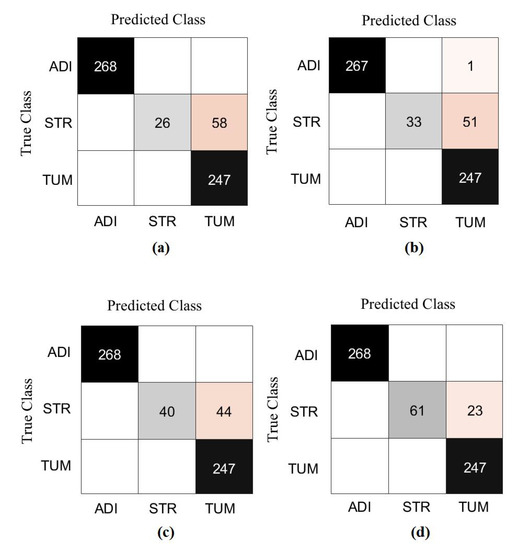
Figure 8.
The confusion matrix results of CRC dataset obtained by: (a) ResNet-50 pre-trained network, (b) DeTraC, (c) 4S-DT, and (d) XDecompo.
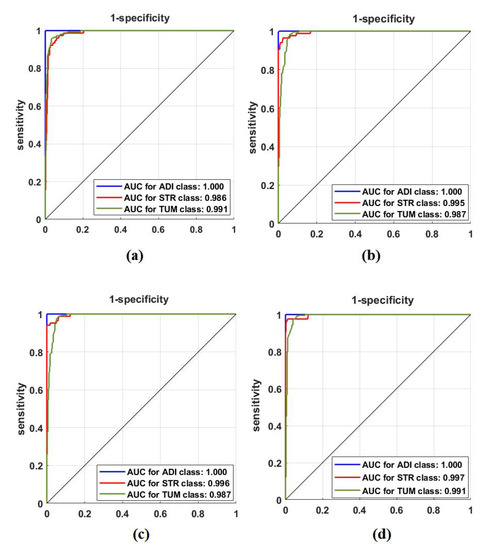
Figure 9.
ROC analysis of the CRC test set obtained by: (a) ResNet-50 pre-trained network, (b) DeTraC, (c) 4S-DT, and (d) XDecompo.
4.5. Classification Performance on Brain Tumour Dataset
For further investigation and to evidence the method’s generalisation and explainability, we evaluate the performance of XDecompo with ResNet-50 (where the fine-tuning mode was used) on the brain tumour test set, see Table 6. All images were resized to 224 × 224 pixels to be suitable for ResNet-50. XDecompo was trained for 50 epochs, 50 mini-batch sizes with a learning rate of 0.0001 for CNN layers, and 0.01 for FC layer. The drop learning rate schedule was set to 0.95 every 4 epochs, a value of 0.001 was set for the regularisation term, and 0.9 for the momentum. For a fair comparison, we used the same parameter settings for each pre-trained model during the training process. Table 8 shows the comparison results obtained by XDecompo, 4S-DT, DeTraC, and the pre-trained network. Figure 10 shows the (AUC) for each class in the test set obtained by each model. As shown by Table 8, XDecompo has the highest overall accuracy with 96.21%, 93.28% for sensitivity, and 97.04% for specificity for classification test images into three classes compared to 4S-DT, DeTraC, and the original classes based on the ResNet-50 pre-trained network. Figure 11 illustrates the confusion matrix obtained by each model for each class in the test set.

Table 8.
Overall classification performance of each model on the testing set of the Brain tumour dataset.

Figure 10.
ROC analysis of the Brain tumour test set obtained by: (a) ResNet-50 pre-trained network, (b) DeTraC, (c) 4S-DT, and (d) XDecompo.
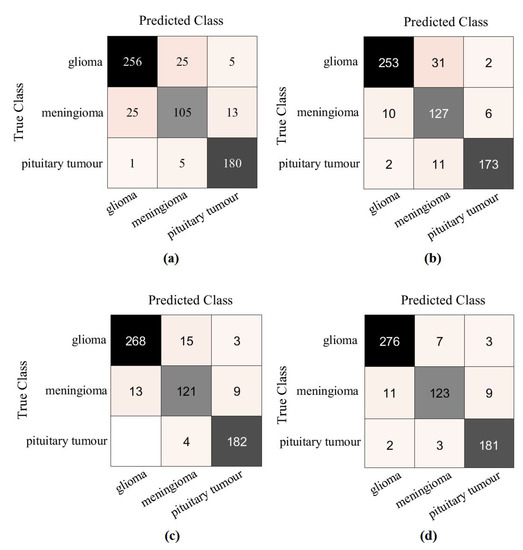
Figure 11.
The confusion matrix results of Brain tumour dataset obtained by: (a) ResNet-50 pre-trained network, (b) DeTraC, (c) 4S-DT, and (d) XDecompo.
Moreover, we demonstrated the high quality of the decomposed classes of the AP-based class decomposition of XDecompo, where we used the same number of classes obtained by XDecompo in the downstream task as in the 4S-DT model, see the third row in Table 5 and Table 6. The results obtained by 4S-DT are reported in Table 9 to support and confirm the importance of the proposed class decomposition of the XDecompo model. Figure 12 illustrates the confusion matrix results obtained in the test sets using the AP-based class decomposition of XDecompo instead of the decomposition component of the 4S-DT model.

Table 9.
Overall classification performance of the 4S-DT model on the CRC and brain tumour testing sets.
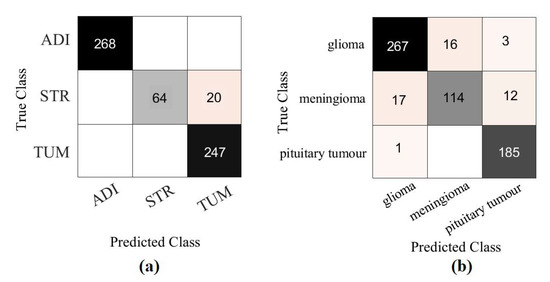
Figure 12.
The confusion matrix results obtained in the test sets by using the AP-based class decomposition of XDecompo instead of the decomposition component of 4S-DT model: (a) CRC dataset, (b) Brain tumour dataset.
Having demonstrated experimentally and quantitatively the effectiveness of XDecompo on two datasets with variations in data irregularities, it is important to demonstrate that such a boosted performance is the result of the effective transferability of features. This can be best demonstrated visually to qualitatively assess the transferred features and their relationship to the predicted class.
Finally, we made a comparison between our results obtained by XDecompo model and different approaches that used the same labelled dataset for the classification of CRC and brain tumour datasets, see Table 10 and Table 11. Please note that the results were obtained by fine-tuning mode and only the weights of the last four layers were updated, see Table 3.

Table 10.
Comparison between the result obtained by XDecompo and different approaches that used the same labelled dataset for the classification of CRC images.

Table 11.
Comparison between the result obtained by XDecompo and different approaches that used the same labelled dataset for the classification of brain tumour images.
4.6. Feature Visualisation
We generate the attention/heatmap of a post hoc explainable model for each model to better understand their behaviour. Here, we used Grad-CAM explainable model for each class in the CRC and brain tumour datasets, where the last convolutional layer was used to extract relevant rich features from the images and generate the final heatmap. In the heatmap, the areas where the CNN model has influenced to are highlighted in red and yellow colours, while the areas in blue colour are less related to the prediction. Figure 13, Figure 14 and Figure 15 show the heatmaps for ADI, STR, and TUM classes, respectively, in the test set of the CRC dataset for each model. Furthermore, Figure 16, Figure 17 and Figure 18 show the heatmaps for glioma, meningioma, and pituitary tumours, respectively, in the test set of the brain tumour dataset for each model. The black arrow refers to the correct region in which the model was able to attend during training, while the red and white arrows refer to the false misleading region and missing detection of the important region in the image, respectively.
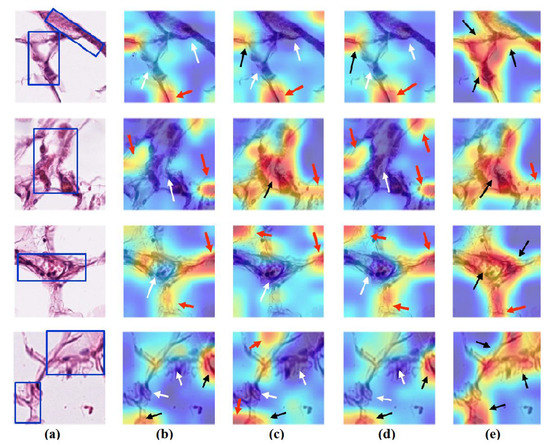
Figure 13.
Visualisation of deep features for class ADI of CRC test set images obtained by each model: (a) original image with the region of interest covered in a blue rectangle, (b) ResNet-50 pre-trained network, (c) DeTraC, (d) 4S-DT, and (e) XDecompo.
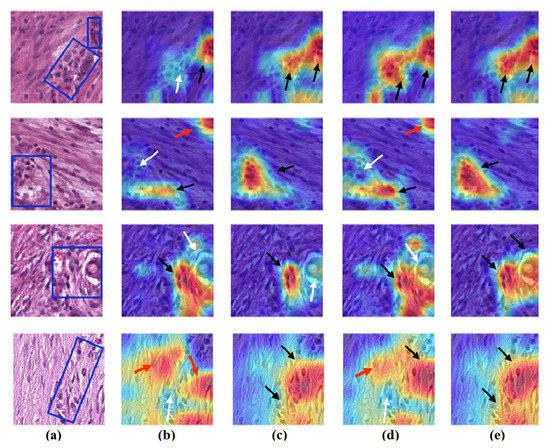
Figure 14.
Visualisation of deep features for class STR of CRC test set images obtained by each model: (a) original image, (b) ResNet-50 pre-trained network, (c) DeTraC, (d) 4S-DT, and (e) XDecompo.
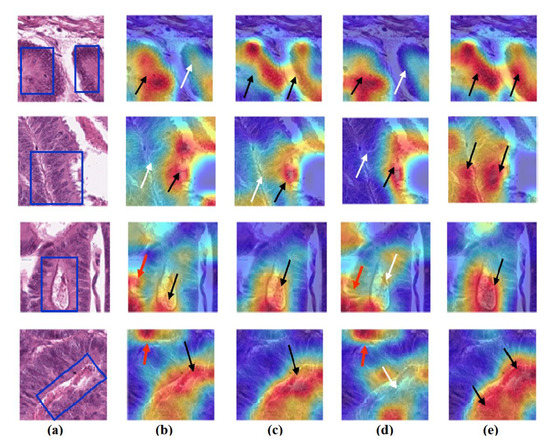
Figure 15.
Visualisation of deep features for class TUM of CRC test set images obtained by each model: (a) original image, (b) ResNet-50 pre-trained network, (c) DeTraC, (d) 4S-DT, and (e) XDecompo.
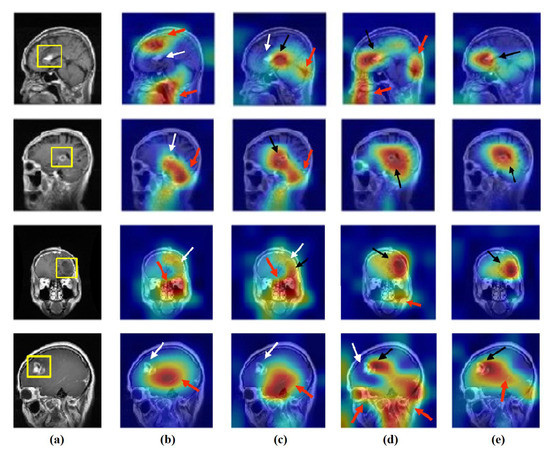
Figure 16.
Visualisation of deep features for class glioma of brain tumour test set images obtained by each model: (a) original image, (b) ResNet-50 pre-trained network, (c) DeTraC, (d) 4S-DT, and (e) XDecompo.
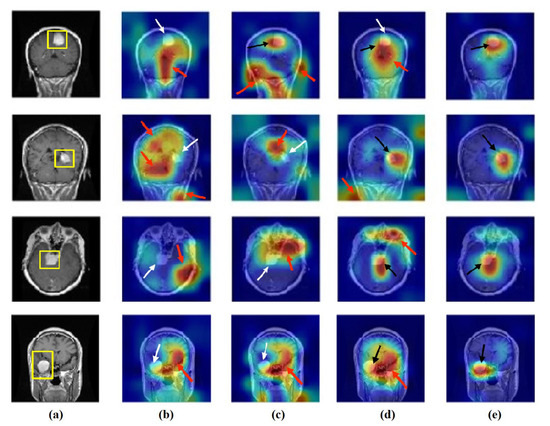
Figure 17.
Visualisation of deep features for class meningioma of brain tumour test set images obtained by each model: (a) original image, (b) ResNet-50 pre-trained network, (c) DeTraC, (d) 4S-DT, and (e) XDecompo.

Figure 18.
Visualisation of deep features for class pituitary tumours of brain tumour test set images obtained by each model: (a) original image, (b) ResNet-50 pre-trained network, (c) DeTraC, (d) 4S-DT, and (e) XDecompo.
As shown, XDecompo can localise more accurate pixels/regions for each class in the images compared 4S-DT model, fine-tuned ResNet-50 network, and DeTraC. More precisely, in Figure 13, XDecompo was able to highlight all the adipose tissue regions (black arrows) compared with other models that failed to find all the adipose tissue regions (white arrows) and attended to other misleading regions (red arrows). Figure 14 and Figure 15 showed the ability of all models to find most of the stromal and epithelial cells, respectively. However, XDecompo outperformed other models in accurately detecting the whole epithelium in the images and avoiding misleading regions (red arrows). Similarly, in the brain tumour test set, XDecompo was able to attend accurately to the specific locations of the different tumour regions in all three classes, while other models attended to false regions (red arrows) and failed to accurately localise the whole tumour regions (white arrows). This experiment validates the highly accurate transferability capability of the proposed model and the high speciality of the features learnt by the model.
5. Discussion and Conclusions
Convolution neural network is one of the most successful approaches in deep learning and can be trained with various strategies. The transfer learning technique considers a practical solution to achieve a significant performance, especially in the medical image domain due to the limitation of the annotated samples. However, the irregularities in the dataset distribution remain the main challenge to providing a robust solution. In [19], 4S-DT has demonstrated its effectiveness in coping with such challenging problems using a self-supervised mechanism (to generate pseudo-labels for a pretext task) with class decomposition method (to classify effectively samples in a downstream task). In this paper, we investigate the effectiveness and generalisation capabilities of a more robust version of 4S-DT, which we call the XDecompo model in handling different medical image datasets. Unlike 4S-DT, we used a self-supervised sample decomposition method with a convolutional autoencoder to generate the pseudo-labels in the pretext task. Moreover, in the downstream tasks, we proposed an automated class decomposition mechanism based on the affinity propagation approach. XDecompo’s class decomposition mechanism showed better performance (and hence a better transferability of the features) in comparison with 4S-DT’s class decomposition. For the CRC dataset, the XDecompo model has achieved an overall accuracy of 97.44% with 90.87% for specificity and 97.82% for sensitivity to classify the test set into three classes. Furthermore, for the brain tumour dataset, XDecompo has achieved the highest overall accuracy of 96.21% with 93.28% for specificity and 97.04% for sensitivity. Qualitatively, the Grad-CAM map showed that XDecompo can accurately localise the most important textures (and regions of interest) in an input image, contributing to accurate predictions. To summarise, XDecompo achieves high classification accuracy (both quantitatively and qualitatively) in different medical image datasets based on fine-tuning mode, compared with the ResNet-50 pre-trained network, DeTraC, and 4S-DT models.
Author Contributions
Conceptualization, M.M.A. and M.M.G.; methodology, M.M.A. and M.M.G.; software, A.A.; validation, A.A.; formal analysis, A.A.; investigation, A.A.; writing—original draft preparation, A.A.; writing—review and editing, M.M.A. and M.M.G.; visualization, A.A.; supervision, M.M.A. and M.M.G.; project administration, M.M.A.; All authors have read and agreed to the published version of the manuscript.
Funding
This research received no external funding.
Institutional Review Board Statement
Not applicable.
Informed Consent Statement
Not applicable.
Data Availability Statement
We have used publicly available datasets. For the colorectal cancer histology dataset, we used the labelled and unlabelled datasets from [58]. For the brain tumour dataset, the unlabelled dataset is publicly available for download at (https://www.kaggle.com/datasets/navoneel/brain-mri-images-for-brain-tumor-detection accessed on 14 November 2022), and the labelled dataset is available at [59].
Conflicts of Interest
The authors declare no conflict of interest.
References
- Sirinukunwattana, K.; Raza, S.E.A.; Tsang, Y.W.; Snead, D.R.; Cree, I.A.; Rajpoot, N.M. Locality sensitive deep learning for detection and classification of nuclei in routine colon cancer histology images. IEEE Trans. Med. Imaging 2016, 35, 1196–1206. [Google Scholar] [CrossRef] [PubMed]
- Sharma, A.K.; Nandal, A.; Dhaka, A.; Koundal, D.; Bogatinoska, D.C.; Alyami, H. Enhanced watershed segmentation algorithm-based modified ResNet50 model for brain tumor detection. BioMed Res. Int. 2022, 2022, 7348344. [Google Scholar] [CrossRef] [PubMed]
- Qureshi, S.A.; Raza, S.E.A.; Hussain, L.; Malibari, A.A.; Nour, M.K.; Rehman, A.U.; Al-Wesabi, F.N.; Hilal, A.M. Intelligent Ultra-Light Deep Learning Model for Multi-Class Brain Tumor Detection. Appl. Sci. 2022, 12, 3715. [Google Scholar] [CrossRef]
- Zadeh Shirazi, A.; Fornaciari, E.; McDonnell, M.D.; Yaghoobi, M.; Cevallos, Y.; Tello-Oquendo, L.; Inca, D.; Gomez, G.A. The application of deep convolutional neural networks to brain cancer images: A survey. J. Pers. Med. 2020, 10, 224. [Google Scholar] [CrossRef] [PubMed]
- Ker, J.; Wang, L.; Rao, J.; Lim, T. Deep learning applications in medical image analysis. IEEE Access 2017, 6, 9375–9389. [Google Scholar] [CrossRef]
- Lundervold, A.S.; Lundervold, A. An overview of deep learning in medical imaging focusing on MRI. Z. Med. Phys. 2019, 29, 102–127. [Google Scholar] [CrossRef]
- Zahoor, M.M.; Qureshi, S.A.; Khan, A.; Rehman, A.u.; Rafique, M. A novel dual-channel brain tumor detection system for MR images using dynamic and static features with conventional machine learning techniques. Waves Random Complex Media 2022, 1–20. [Google Scholar] [CrossRef]
- LeCun, Y.; Bengio, Y.; Hinton, G. Deep learning. Nature 2015, 521, 436. [Google Scholar] [CrossRef]
- Anwar, S.M.; Majid, M.; Qayyum, A.; Awais, M.; Alnowami, M.; Khan, M.K. Medical image analysis using convolutional neural networks: A review. J. Med. Syst. 2018, 42, 1–13. [Google Scholar] [CrossRef]
- Wang, Z.; Yan, W.; Oates, T. Time series classification from scratch with deep neural networks: A strong baseline. In Proceedings of the 2017 International Joint Conference on Neural Networks (IJCNN), Anchorage, AK, USA, 14–19 May 2017; pp. 1578–1585. [Google Scholar]
- Zhuang, F.; Qi, Z.; Duan, K.; Xi, D.; Zhu, Y.; Zhu, H.; Xiong, H.; He, Q. A comprehensive survey on transfer learning. Proc. IEEE 2020, 109, 43–76. [Google Scholar] [CrossRef]
- Alzubaidi, L.; Al-Amidie, M.; Al-Asadi, A.; Humaidi, A.J.; Al-Shamma, O.; Fadhel, M.A.; Zhang, J.; Santamaría, J.; Duan, Y. Novel Transfer Learning Approach for Medical Imaging with Limited Labeled Data. Cancers 2021, 13, 1590. [Google Scholar] [CrossRef]
- Abbas, A.; Abdelsamea, M.M. Learning transformations for automated classification of manifestation of tuberculosis using convolutional neural network. In Proceedings of the 2018 13th International Conference on Computer Engineering and Systems (ICCES), Cairo, Egypt, 18–19 December 2018; pp. 122–126. [Google Scholar]
- Lu, J.; Behbood, V.; Hao, P.; Zuo, H.; Xue, S.; Zhang, G. Transfer learning using computational intelligence: A survey. Knowl.-Based Syst. 2015, 80, 14–23. [Google Scholar] [CrossRef]
- Delalleau, O.; Bengio, Y. Shallow vs. deep sum-product networks. Adv. Neural Inf. Process. Syst. 2011, 24, 14–23. [Google Scholar]
- Ciresan, D.C.; Meier, U.; Masci, J.; Gambardella, L.M.; Schmidhuber, J. Flexible, high performance convolutional neural networks for image classification. In Proceedings of the Twenty-Second International Joint Conference on Artificial Intelligence, Barcelona, Spain, 16–22 July 2011. [Google Scholar]
- Tajbakhsh, N.; Shin, J.Y.; Gurudu, S.R.; Hurst, R.T.; Kendall, C.B.; Gotway, M.B.; Liang, J. Convolutional neural networks for medical image analysis: Full training or fine tuning? IEEE Trans. Med. Imaging 2016, 35, 1299–1312. [Google Scholar] [CrossRef]
- Liu, X.; Zhang, F.; Hou, Z.; Mian, L.; Wang, Z.; Zhang, J.; Tang, J. Self-supervised learning: Generative or contrastive. IEEE Trans. Knowl. Data Eng. 2021, 35, 857–876. [Google Scholar] [CrossRef]
- Abbas, A.; Abdelsamea, M.M.; Gaber, M.M. 4S-DT: Self-Supervised Super Sample Decomposition for Transfer Learning With Application to COVID-19 Detection. IEEE Trans. Neural Netw. Learn. Syst. 2021, 32, 2798–2808. [Google Scholar] [CrossRef]
- Frey, B.J.; Dueck, D. Clustering by passing messages between data points. Science 2007, 315, 972–976. [Google Scholar] [CrossRef]
- Ribeiro, E.; Uhl, A.; Häfner, M. Colonic polyp classification with convolutional neural networks. In Proceedings of the 2016 IEEE 29th International Symposium on Computer-Based Medical Systems (CBMS), Belfast and Dublin, Ireland, 20–24 June 2016; pp. 253–258. [Google Scholar]
- Haj-Hassan, H.; Chaddad, A.; Harkouss, Y.; Desrosiers, C.; Toews, M.; Tanougast, C. Classifications of multispectral colorectal cancer tissues using convolution neural network. J. Pathol. Inform. 2017, 8, 1. [Google Scholar] [CrossRef]
- Wang, W.; Tian, J.; Zhang, C.; Luo, Y.; Wang, X.; Li, J. An improved deep learning approach and its applications on colonic polyp images detection. BMC Med. Imaging 2020, 20, 1–14. [Google Scholar] [CrossRef]
- Ponzio, F.; Macii, E.; Ficarra, E.; Di Cataldo, S. Colorectal cancer classification using deep convolutional networks. In Proceedings of the 11th International Joint Conference on Biomedical Engineering Systems and Technologies, Funchal, Madeira, Portugal, 19 January 2018; Volume 2, pp. 58–66. [Google Scholar]
- Kokkalla, S.; Kakarla, J.; Venkateswarlu, I.B.; Singh, M. Three-class brain tumor classification using deep dense inception residual network. Soft Comput. 2021, 25, 8721–8729. [Google Scholar] [CrossRef]
- Deepak, S.; Ameer, P. Brain tumor classification using deep CNN features via transfer learning. Comput. Biol. Med. 2019, 111, 103345. [Google Scholar] [CrossRef] [PubMed]
- Alqudah, A.M.; Alquraan, H.; Qasmieh, I.A.; Alqudah, A.; Al-Sharu, W. Brain Tumor Classification Using Deep Learning Technique—A Comparison between Cropped, Uncropped, and Segmented Lesion Images with Different Sizes. arXiv 2020, arXiv:2001.08844. [Google Scholar] [CrossRef]
- Abd El Kader, I.; Xu, G.; Shuai, Z.; Saminu, S.; Javaid, I.; Salim Ahmad, I. Differential deep convolutional neural network model for brain tumor classification. Brain Sci. 2021, 11, 352. [Google Scholar] [CrossRef] [PubMed]
- Sajjad, M.; Khan, S.; Muhammad, K.; Wu, W.; Ullah, A.; Baik, S.W. Multi-grade brain tumor classification using deep CNN with extensive data augmentation. J. Comput. Sci. 2019, 30, 174–182. [Google Scholar] [CrossRef]
- He, H.; Garcia, E.A. Learning from imbalanced data. IEEE Trans. Knowl. Data Eng. 2009, 21, 1263–1284. [Google Scholar]
- Chawla, N.V.; Japkowicz, N.; Kotcz, A. Special issue on learning from imbalanced data sets. ACM Sigkdd Explor. Newsl. 2004, 6, 1–6. [Google Scholar] [CrossRef]
- Stefanowski, J. Overlapping, rare examples and class decomposition in learning classifiers from imbalanced data. In Emerging Paradigms in Machine Learning; Springer: Berlin/Heidelberg, Germany, 2013; pp. 277–306. [Google Scholar]
- Mugova, N.P.; Abdelsamea, M.M.; Gaber, M.M. On The Effect Of Decomposition Granularity On DeTraC For COVID-19 Detection Using Chest X-Ray Images. In Proceedings of the ECMS, Online, 31 May–2 June 2021; pp. 29–34. [Google Scholar]
- Abbas, A.; Abdelsamea, M.M.; Gaber, M.M. Detrac: Transfer learning of class decomposed medical images in convolutional neural networks. IEEE Access 2020, 8, 74901–74913. [Google Scholar] [CrossRef]
- Jing, L.; Tian, Y. Self-supervised visual feature learning with deep neural networks: A survey. IEEE Trans. Pattern Anal. Mach. Intell. 2020, 43, 4037–4058. [Google Scholar] [CrossRef]
- Chen, L.; Bentley, P.; Mori, K.; Misawa, K.; Fujiwara, M.; Rueckert, D. Self-supervised learning for medical image analysis using image context restoration. Med. Image Anal. 2019, 58, 101539. [Google Scholar] [CrossRef]
- Zeiler, M.D.; Fergus, R. Visualizing and understanding convolutional networks. In Proceedings of the European Conference on Computer Vision, Zurich, Switzerland, 6–12 September 2014; Springer: Cham, Switzerland, 2014; pp. 818–833. [Google Scholar]
- Guidotti, R.; Monreale, A.; Ruggieri, S.; Turini, F.; Giannotti, F.; Pedreschi, D. A survey of methods for explaining black box models. ACM Comput. Surv. (CSUR) 2018, 51, 1–42. [Google Scholar] [CrossRef]
- Gunning, D.; Stefik, M.; Choi, J.; Miller, T.; Stumpf, S.; Yang, G.Z. XAI—Explainable artificial intelligence. Sci. Robot. 2019, 4, eaay7120. [Google Scholar] [CrossRef]
- Redmon, J.; Divvala, S.; Girshick, R.; Farhadi, A. You only look once: Unified, real-time object detection. In Proceedings of the IEEE Conference on Computer Vision and Pattern Recognition, Las Vegas, NV, USA, 27–30 June 2016; pp. 779–788. [Google Scholar]
- Adadi, A.; Berrada, M. Peeking inside the black-box: A survey on explainable artificial intelligence (XAI). IEEE Access 2018, 6, 52138–52160. [Google Scholar] [CrossRef]
- Arrieta, A.B.; Díaz-Rodríguez, N.; Del Ser, J.; Bennetot, A.; Tabik, S.; Barbado, A.; García, S.; Gil-López, S.; Molina, D.; Benjamins, R.; et al. Explainable Artificial Intelligence (XAI): Concepts, taxonomies, opportunities and challenges toward responsible AI. Inf. Fusion 2020, 58, 82–115. [Google Scholar] [CrossRef]
- Bahdanau, D.; Cho, K.; Bengio, Y. Neural machine translation by jointly learning to align and translate. arXiv 2014, arXiv:1409.0473. [Google Scholar]
- Oord, A.v.d.; Dieleman, S.; Zen, H.; Simonyan, K.; Vinyals, O.; Graves, A.; Kalchbrenner, N.; Senior, A.; Kavukcuoglu, K. Wavenet: A generative model for raw audio. arXiv 2016, arXiv:1609.03499. [Google Scholar]
- Caruana, R.; Lou, Y.; Gehrke, J.; Koch, P.; Sturm, M.; Elhadad, N. Intelligible models for healthcare: Predicting pneumonia risk and hospital 30-day readmission. In Proceedings of the 21th ACM SIGKDD International Conference on Knowledge Discovery and Data Mining, Sydney, NSW, Australia, 10–13 August 2015; pp. 1721–1730. [Google Scholar]
- Zintgraf, L.M.; Cohen, T.S.; Adel, T.; Welling, M. Visualizing deep neural network decisions: Prediction difference analysis. arXiv 2017, arXiv:1702.04595. [Google Scholar]
- Jetley, S.; Lord, N.A.; Lee, N.; Torr, P.H.S. Learn To Pay Attention. arXiv 2018, arXiv:1804.02391. [Google Scholar]
- Niu, Z.; Zhong, G.; Yu, H. A review on the attention mechanism of deep learning. Neurocomputing 2021, 452, 48–62. [Google Scholar] [CrossRef]
- Simonyan, K.; Vedaldi, A.; Zisserman, A. Deep Inside Convolutional Networks: Visualising Image Classification Models and Saliency Maps. arXiv 2014, arXiv:1312.6034. [Google Scholar]
- Zhou, B.; Khosla, A.; Lapedriza, A.; Oliva, A.; Torralba, A. Learning deep features for discriminative localization. In Proceedings of the IEEE Conference on Computer Vision and Pattern Recognition, Las Vegas, NV, USA, 27–30 June 2016; pp. 2921–2929. [Google Scholar]
- Selvaraju, R.R.; Cogswell, M.; Das, A.; Vedantam, R.; Parikh, D.; Batra, D. Grad-cam: Visual explanations from deep networks via gradient-based localization. In Proceedings of the IEEE International Conference on Computer Vision, Venice, Italy, 22–29 October 2017; pp. 618–626. [Google Scholar]
- Ester, M.; Kriegel, H.P.; Sander, J.; Xu, X. A density-based algorithm for discovering clusters in large spatial databases with noise. In Proceedings of the kdd, Portland, OR, USA, 2 August 1996; Volume 96, pp. 226–231. [Google Scholar]
- Robbins, H.; Monro, S. A stochastic approximation method. Ann. Math. Stat. 1951, 22, 400–407. [Google Scholar] [CrossRef]
- Selvaraju, R.R.; Das, A.; Vedantam, R.; Cogswell, M.; Parikh, D.; Batra, D. Grad-CAM: Why did you say that? arXiv 2016, arXiv:1611.07450. [Google Scholar]
- Chen, M.; Shi, X.; Zhang, Y.; Wu, D.; Guizani, M. Deep features learning for medical image analysis with convolutional autoencoder neural network. IEEE Trans. Big Data 2017, 7, 750–758. [Google Scholar] [CrossRef]
- Wold, S.; Esbensen, K.; Geladi, P. Principal component analysis. Chemom. Intell. Lab. Syst. 1987, 2, 37–52. [Google Scholar] [CrossRef]
- Abdelsamea, M.M.; Zidan, U.; Senousy, Z.; Gaber, M.M.; Rakha, E.; Ilyas, M. A survey on artificial intelligence in histopathology image analysis. Wiley Interdiscip. Rev. Data Min. Knowl. Discov. 2022, 12, e1474. [Google Scholar] [CrossRef]
- Macenko, M.; Niethammer, M.; Marron, J.S.; Borland, D.; Woosley, J.T.; Guan, X.; Schmitt, C.; Thomas, N.E. A method for normalizing histology slides for quantitative analysis. In Proceedings of the 2009 IEEE International Symposium on Biomedical Imaging: From Nano to Macro, Boston, MA, USA, 28 June–1 July 2009; pp. 1107–1110. [Google Scholar]
- Badža, M.M.; Barjaktarović, M.Č. Classification of brain tumors from MRI images using a convolutional neural network. Appl. Sci. 2020, 10, 1999. [Google Scholar] [CrossRef]
- He, K.; Zhang, X.; Ren, S.; Sun, J. Deep residual learning for image recognition. In Proceedings of the IEEE Conference on Computer Vision and Pattern Recognition, Las Vegas, NV, USA, 27–30 June 2016; pp. 770–778. [Google Scholar]
- Dudani, S. The distance-weighted k-nearest neighbor rule. IEEE Trans. Syst. Man Cybern. 1978, 8, 311–313. [Google Scholar] [CrossRef]
- Krizhevsky, A.; Sutskever, I.; Hinton, G.E. Imagenet classification with deep convolutional neural networks. In Proceedings of the Advances in Neural Information Processing Systems, Lake Tahoe, NV, USA, 3 December 2012; pp. 1097–1105. [Google Scholar]
- Wu, X.; Kumar, V.; Quinlan, J.R.; Ghosh, J.; Yang, Q.; Motoda, H.; McLachlan, G.J.; Ng, A.; Liu, B.; Philip, S.Y.; et al. Top 10 algorithms in data mining. Knowl. Inf. Syst. 2008, 14, 1–37. [Google Scholar] [CrossRef]
- Peng, T.; Boxberg, M.; Weichert, W.; Navab, N.; Marr, C. Multi-task learning of a deep k-nearest neighbour network for histopathological image classification and retrieval. In Proceedings of the International Conference on Medical Image Computing and Computer-Assisted Intervention, Shenzhen, China, 13–17 October 2019; Springer: Cham, Switzerland, 2019; pp. 676–684. [Google Scholar]
- Ghosh, S.; Bandyopadhyay, A.; Sahay, S.; Ghosh, R.; Kundu, I.; Santosh, K. Colorectal histology tumor detection using ensemble deep neural network. Eng. Appl. Artif. Intell. 2021, 100, 104202. [Google Scholar] [CrossRef]
- Li, X.; Jonnagaddala, J.; Cen, M.; Zhang, H.; Xu, S. Colorectal cancer survival prediction using deep distribution based multiple-instance learning. Entropy 2022, 24, 1669. [Google Scholar] [CrossRef]
- Kather, J.N.; Krisam, J.; Charoentong, P.; Luedde, T.; Herpel, E.; Weis, C.A.; Gaiser, T.; Marx, A.; Valous, N.A.; Ferber, D.; et al. Predicting survival from colorectal cancer histology slides using deep learning: A retrospective multicenter study. PLoS Med. 2019, 16, e1002730. [Google Scholar] [CrossRef]
- Abiwinanda, N.; Hanif, M.; Hesaputra, S.T.; Handayani, A.; Mengko, T.R. Brain tumor classification using convolutional neural network. In Proceedings of the World Congress on Medical Physics and Biomedical Engineering 2018, Prague, Czech Republic, 3–8 June 2018; Springer: Singapore, 2019; pp. 183–189. [Google Scholar]
- Cheng, J.; Huang, W.; Cao, S.; Yang, R.; Yang, W.; Yun, Z.; Wang, Z.; Feng, Q. Enhanced performance of brain tumor classification via tumor region augmentation and partition. PLoS ONE 2015, 10, e0140381. [Google Scholar] [CrossRef]
- Pashaei, A.; Sajedi, H.; Jazayeri, N. Brain Tumor Classification via Convolutional Neural Network and Extreme Learning Machines. In Proceedings of the 2018 8th International Conference on Computer and Knowledge Engineering (ICCKE), Mashhad, Iran, 25–26 October 2018; pp. 314–319. [Google Scholar] [CrossRef]
- Tazin, T.; Sarker, S.; Gupta, P.; Ayaz, F.I.; Islam, S.; Monirujjaman Khan, M.; Bourouis, S.; Idris, S.A.; Alshazly, H. A robust and novel approach for brain tumor classification using convolutional neural network. Comput. Intell. Neurosci. 2021, 2021, 2392395. [Google Scholar] [CrossRef]
- Afshar, P.; Plataniotis, K.N.; Mohammadi, A. Capsule networks for brain tumor classification based on MRI images and coarse tumor boundaries. In Proceedings of the ICASSP 2019-2019 IEEE International Conference on Acoustics, Speech and Signal Processing (ICASSP), Brighton, UK, 12–17 May 2019; pp. 1368–1372. [Google Scholar]
Publisher’s Note: MDPI stays neutral with regard to jurisdictional claims in published maps and institutional affiliations. |
© 2022 by the authors. Licensee MDPI, Basel, Switzerland. This article is an open access article distributed under the terms and conditions of the Creative Commons Attribution (CC BY) license (https://creativecommons.org/licenses/by/4.0/).